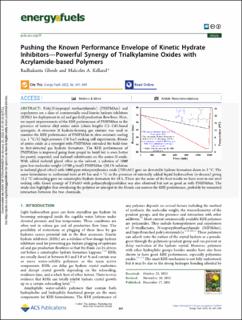| dc.contributor.author | Ghosh, Radhakanta | |
| dc.contributor.author | Kelland, Malcolm Andrew | |
| dc.date.accessioned | 2022-01-27T14:21:46Z | |
| dc.date.available | 2022-01-27T14:21:46Z | |
| dc.date.created | 2022-01-20T08:51:03Z | |
| dc.date.issued | 2021-12 | |
| dc.identifier.citation | Ghosh, R., Kelland, M.A. (2022) Pushing the Known Performance Envelope of Kinetic Hydrate Inhibitors - Powerful Synergy of Trialkylamine Oxides with Acrylamide-based Polymers. Energy & Fuels, 36(1), 341-349. | en_US |
| dc.identifier.issn | 0887-0624 | |
| dc.identifier.uri | https://hdl.handle.net/11250/2892841 | |
| dc.description.abstract | Poly(N-isopropyl methacrylamide) (PNIPMAm) and copolymers are a class of commercially used kinetic hydrate inhibitors (KHIs) for deployment in oil and gas field production flow lines. Here, we report improvements of the KHI performance of PNIPMAm in the presence of various alkyl amine oxide (chain lengths C3–C6)-based synergists. A structure II hydrate-forming gas mixture was used to examine the KHI performance of PNIPMAm in slow constant cooling (ca. 1 °C/h) high-pressure (76 bar) rocking cell experiments. Blends of amine oxide as a synergist with PNIPMAm extended the hold time to first-detected gas hydrate formation. The KHI performance of PNIPMAm is improved going from propyl to butyl but is even better for pentyl, isopentyl, and isohexyl substituents on the amine-N-oxide. With added isobutyl glycol ether as the solvent, a solution of 1000 ppm low-molecular-weight (4700 g/mol) PNIPMAm (20.1% solution in isobutyl glycol ether) with 1000 ppm triisopentylamine oxide (TiPeAO) gave no detectable hydrate formation down to 2 °C. The same formulation in isothermal tests at 68 bar and 4 °C in the presence of externally added liquid hydrocarbon (n-decane) giving 15.5 °C subcooling gave no catastrophic hydrate formation for 48 h. These are the some of the best results we have seen in our steel rocking cells. Good synergy of TiPeAO with polyacryloylpyrrolidine was also observed but not as good as with PNIPMAm. The study also highlights that overdosing the polymer or synergist in the blends can worsen the KHI performance, probably by unwanted interaction between the two chemicals. | en_US |
| dc.language.iso | eng | en_US |
| dc.publisher | American Chemical Society | en_US |
| dc.rights | Navngivelse 4.0 Internasjonal | * |
| dc.rights.uri | http://creativecommons.org/licenses/by/4.0/deed.no | * |
| dc.subject | kjemi | en_US |
| dc.subject | polymer | en_US |
| dc.subject | løsemidler | en_US |
| dc.title | Pushing the Known Performance Envelope of Kinetic Hydrate Inhibitors - Powerful Synergy of Trialkylamine Oxides with Acrylamide-based Polymers | en_US |
| dc.type | Peer reviewed | en_US |
| dc.type | Journal article | en_US |
| dc.description.version | publishedVersion | en_US |
| dc.rights.holder | © 2021 The Authors. | en_US |
| dc.subject.nsi | VDP::Matematikk og Naturvitenskap: 400::Kjemi: 440 | en_US |
| dc.source.pagenumber | 341-349 | en_US |
| dc.source.volume | 36 | en_US |
| dc.source.journal | Energy & Fuels | en_US |
| dc.source.issue | 1 | en_US |
| dc.identifier.doi | 10.1021/acs.energyfuels.1c03609 | |
| dc.identifier.cristin | 1985620 | |
| cristin.ispublished | true | |
| cristin.fulltext | original | |
| cristin.qualitycode | 2 | |

